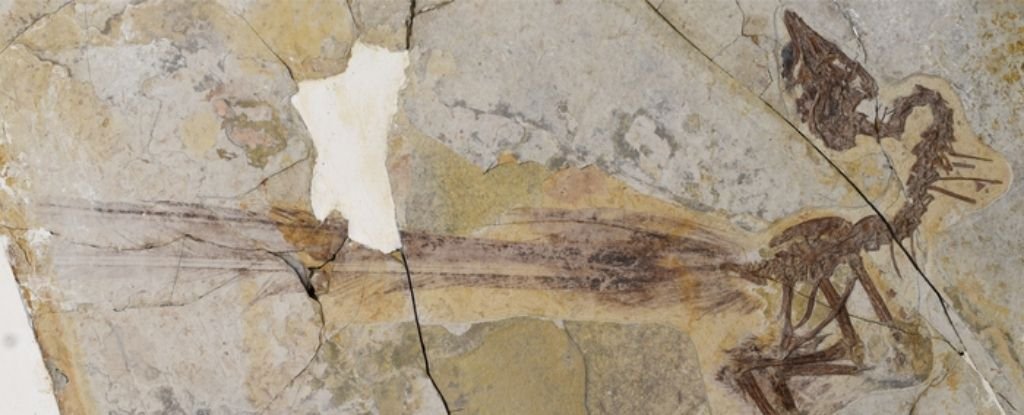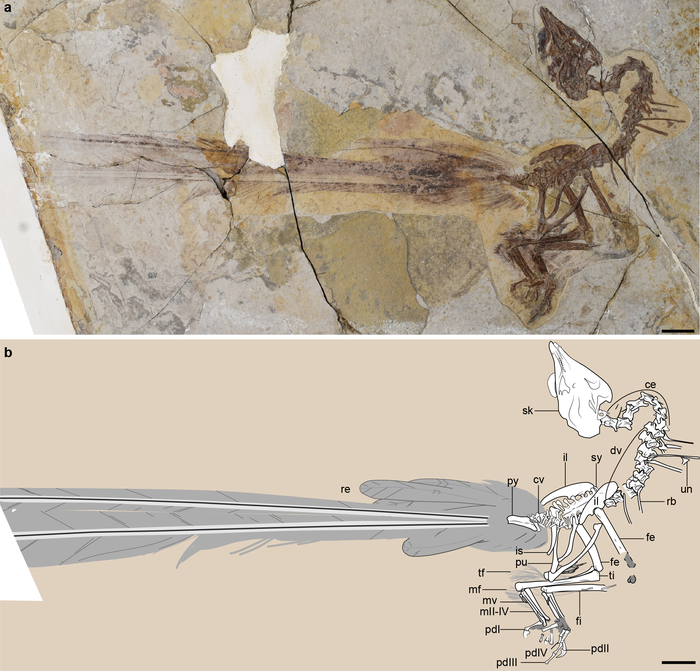
Posted on 09/17/2021 12:25:28 PM PDT by Red Badger

Nothing quite says 'look at me!' like an extravagant set of tail feathers. Plenty of modern birds sacrifice agility for a chance to grab attention, but examples among relatives in the fossil record have been harder to come by.
Scientists have now described the remains of a 120-million-year-old feathered dinosaur roughly the size of a bluejay, with an extremely long and extravagant behind.
The remarkably-detailed fossil was found in northeastern China and named Yuanchuavis (Yuanchuavis kompsosoura) after a phoenix-like bird in Chinese mythology.
It's the first time a bird-like fossil from the Mesozoic era has been discovered with such a complex array of tail feathers, featuring both a grey fantail and a pair of long black plumes.
The two extensive, dark feathers stretch roughly 30 centimeters (12 inches), about 1.3 times longer than the bird's body. Together with the fan of shorter feathers, they create a pintail that the authors say "strongly resembles" those of modern sunbirds and quetzals, which use their ostentatious behinds to attract mates.
The discovery suggests even the earliest birds were using their feathers to do something similar.
But being sexy can have its burdens. A tail as large and flashy as the one seen on Yuanchuavis would have made flying and evading predators a whole lot trickier.
Clearly, the risks of the booty call were worth it.
"Scientists call a trait like a big fancy tail an 'honest signal,' because it is detrimental, so if an animal with it is able to survive with that handicap, that's a sign that it's really fit," explains paleontologist Jingmai O'Connor from Chicago's Field Museum.
"A female bird would look at a male with goofily burdensome tail feathers and think, 'Dang, if he's able to survive even with such a ridiculous tail, he must have really good genes.'"

The fossil of Yuanchuavis with a corresponding illustration of the tail feathers. (Wang et al., Current Biology, 2021)
_____________________________________________________________________________
Yuanchuavis belongs to a group of Mesozoic avians called enantiornithes or "opposite birds", which lie on their own evolutionary branch somewhere in between the ancestor of modern birds and extinct non-avian dinosaurs.
Enantiornithes are actually a sister clade to ornithuromorpha, to which all living birds belong. After coexisting side by side for about 65 million years, only one of these clades survived the mass extinction event that wiped out most dinosaurs.
Figuring out why one clade of avians survived while the other didn't could allow us to better understand how modern birds have been so successful at getting by in this world.
Way back in the Mesozoic era, the ancestors of modern birds did not seem to have long tail ornaments like those found on Yuanchuavis, although they do show fan tails in the fossil record.
In fact, for many years, fan tails were thought to have evolved exclusively in ornithuromorphs. Recently, however, several fossils of enantiornithes have been found with this feature as well.
Yuanchuavis is even more peculiar. Its tail's mix of fantail and paired plumes is a feature no other bird in its clade has been found to possess.
The authors can't be sure why Yuanchuavis evolved such a complex tail, but given how aerodynamically inconvenient the feathers would have been, they suspect these plumages were shaped by sexual selection.
In a densely forested environment, where most enantiornithes are thought to have lived, there are lots of things to hide and flee behind. A cumbersome tail might not be so bad if it's pretty enough. Today, that's where we find most birds of paradise.
But in the more open, semi-aquatic environments where most ornithuromorphs in the Mesozoic lived, the trade-off between sex and survival might not have been as worthwhile.
The differing landscapes could be part of the reason why enantiornithines seemed to have evolved pintails earlier than their sister clade.
"It is well known that sexual selection plays a central role in speciation and recognition in modern birds, attesting to the enormous extravagant feathers, ornaments, vocals, and dances," explains Wang.
"However, it is notoriously difficult to tell if a given fossilized structure is shaped by sexual selection, considering the imperfect nature of the fossil record. Therefore, the well-preserved tail feathers in this new fossil bird provide great new information about how sexual selection has shaped the avian tail from their earliest stage."
The study was published in Current Biology.
Apparently, 120 million years ago somebody liked big butts.
I thought the title was about Mazzie Hirono.
“A female bird would look at a male with goofily burdensome tail feathers and think, ‘Dang, if he’s able to survive even with such a ridiculous tail, he must have really good genes.’” …No, because birds even back then acted on instinct and did not think.
The Peacock strategy mixed with long tails for jumping from branch to branch like squirrels. Nothing impractical about it.
An early version of style over substance;
i.e. ‘Don’t hate me because I’m beautiful!”


>>>The Peacock strategy mixed with long tails for jumping from branch to branch like squirrels. Nothing impractical about it.<<<
Normally we think, “Faith cometh by hearing, and hearing by the word of God,” meaning that we get saving faith from hearing/reading the Bible, God’s word. But it is just as true that “faith cometh by hearing . . .”
If you listen enough to evolutionists, you gain faith in it as a religion (which is really all it is). It takes more faith to believe the ridiculous claims of evolution than to simply accept the fact of a Creator/a Designer.
“The fool hath said in his heart, there is no God.”
No big butt indicated in the skeletal fossil, just long feathers.
Was wondering about weird phrasing of Carly Cassela trying to sound ghetto hip in a science article.
Turns out her dad, Chris Cassela is founder of Science Alert....so she can do anything.
“120 million year old”
With that as the premise of the story, everything that follows has to be BS.
Birds of a feather, seek sex together....
Birds of a feather, seek sex together....
:max_bytes(150000):strip_icc()/GettyImages-91740234-446238700d12404cb687e0fafc80b92e.jpg)
Maybe just a weird bird that liked to stick other bird’s feathers up its butt.
If you've ever seen a Roadrunner skillfully SNIP a leg off a baby Quail in order to keep it from running away..
NBC’s peacock before they switched to color.
I was thinking the same thing. Peacock, and they mostly use theirs for courting display and wooing a mate during the season.
I think you nailed it. Roadrunner...
Disclaimer: Opinions posted on Free Republic are those of the individual posters and do not necessarily represent the opinion of Free Republic or its management. All materials posted herein are protected by copyright law and the exemption for fair use of copyrighted works.